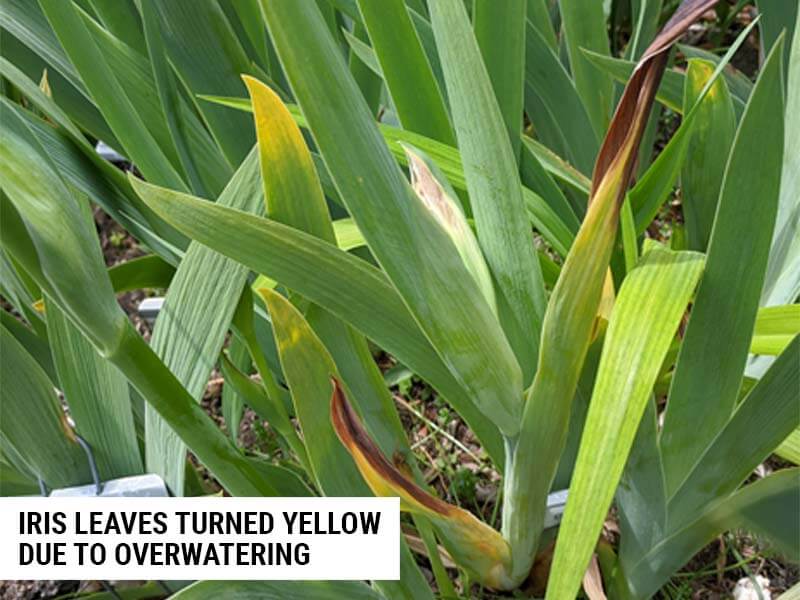Iris leaves that were once a lush green taking on a sickly yellow hue can be worrying for any gardener. Yellowing leaves are often the first visible sign that something is amiss with your iris plants. But don’t panic – yellowing leaves can often be easily corrected if you know the underlying causes. Here we’ll explore the main reasons for yellow iris leaves and effective solutions to restore their vibrant color.
Overwatering
Excess moisture is one of the most common culprits when iris leaves turn yellow. Irises prefer soil on the drier side and are prone to root rot if overwatered. Prolonged soggy conditions suffocate the roots, causing them distress.
Check that your iris has well-draining soil and is not planted in a spot that collects water Clay-heavy soils may need amendments with compost or grit to improve drainage Allow the top few inches of soil to dry out between waterings, Increase spacing between plants to encourage air circulation, Monitor new transplants closely as their damaged roots are extra sensitive to wetness, Adjusting your watering habits is key to preventing wet feet problems,
Underwatering
While overwatering is more often the issue lack of water can also cause yellowing. If drought conditions occur for too long, iris leaves will yellow and become dried out under water stress. Leaves may wrinkle or appear wilted even when the soil feels slightly damp.
Water thoroughly whenever the top few inches become dry. In very hot or windy conditions, daily watering may be needed to replenish moisture lost through evaporation and transpiration. Mulching around the iris conserves moisture and moderates soil temperature. Monitor for underwater stress and adjust your irrigation accordingly.
Nutrient Deficiencies
An improper balance of nutrients can trigger yellowing leaves. Certain deficiencies are commonly seen:
-
Nitrogen deficiency causes uniform yellowing across the whole plant. Apply a nitrogen-rich organic fertilizer.
-
Iron shortage leads to yellowing between the leaf veins. Foliar sprays of iron supplements can help.
-
Lack of magnesium first yellows older leaves while veins remain green. Apply Epsom salts.
Have your soil tested to identify any imbalances. Adjust pH if needed and fertilize regularly with a complete formula for iris. Go easy on nitrogen which can spur excessive foliage over flowers.
Root Damage
Any damage to the root system of an iris can interrupt its ability to take up nutrients and moisture. Main causes of root problems include:
-
Transplant shock from disturbed roots when planting or dividing iris.
-
Feeder roots lost to rot from overwatering.
-
Root nibbling from iris borers or other pests.
-
Mechanical damage from digging or cultivation around the plant.
Careful transplanting and attentive watering habits prevent many issues. Control borers by removing and destroying affected rhizomes. Minimize digging around established plants to avoid inadvertent root damage. Damaged roots take time to regenerate, so patience is required.
Pests or Diseases
Insects, mites, and plant diseases can all make iris leaves yellow. Here are some prime suspects to watch for:
-
Iris borers chew through leaves and rhizomes leaving yellow trails or holes. Hand pick borers and larvae when found.
-
Spider mites suck cell contents causing stippling and discoloration. Knock off with hose or use insecticidal soap sprays.
-
Bacterial soft rot turns leaves to mushy yellow messes, beginning at the leaf tips. Improve drainage and destroy badly infected plants.
-
Leaf spot fungal diseases create yellow lesions. Avoid overhead irrigation and remove affected leaves promptly.
Early monitoring allows you to take quick action at the first sign of infestation. Target treatments to control specific pests or diseases present. Maintain optimal growing conditions to avoid stress that invites problems.
Environmental Factors
Sometimes yellowing has nothing to do with the roots or leaves but is caused by environmental conditions. Common situations include:
-
Sunscald, where leaves yellow from intense winter sunlight without insulating snow cover.
-
Frost damage, identified by limp yellowed foliage after a hard freeze. Shelter plants or provide winter mulch.
-
Heat stress, causing marginal leaf scorch. Shade plants during hot spells.
-
Wind damage, which desiccates and yellows exposed foliage. Provide a windbreak.
-
Chemical injury from road salt or herbicides. Avoid planting irises in vulnerable areas.
While we can’t control the weather, adjusting cultural practices can help minimize environmental damage to iris plants. Proper site selection and preparation is your first line of defense.
First Aid for Yellow Leaves
When your Yellow Iris starts to resemble a sad, soggy salad, its time to rethink watering. Heres how to stop drowning your plant in love:
- Check soil moisture before watering. If its damp, skip the drink.
- To keep your tips from getting burned, use filtered water or let tap water sit.
- To keep fungi away and make sure the roots get enough water, water at the base.
- If you can feel that the top inch of soil is dry, it’s time to water.
️ Thirsty Roots: The Underwatering Problem
Conversely, leaves that are dry and crispy as autumn foliage scream underwatering. If the soil is bone-dry, your Iris is calling for a drink. Aim for soil thats moist, not a desert, to keep those roots happily hydrated.
Iris Care: Pests and Disease
FAQ
How often should I water my iris?
Why is my eye iris turning yellow?
How do you rejuvenate irises?
- A Complete Guide to Caring for Yuki Cherry Blossom Shrub - January 23, 2025
- Identifying Red Hot Poker Seeds: What to Look For When Harvesting Torch Lily Pods - January 23, 2025
- A Complete Guide to Harvesting Evening Primrose Seeds - January 23, 2025

